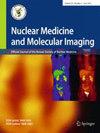Diagnosis of Fungal Infection (Candida albicans) After Heart Transplantation in a Pediatric Case with Fever of Unknown Origin: Role of 99mTc-UBI SPECT/CT and 18F-FDG PET/CT.
IF 2.7
Q3 RADIOLOGY, NUCLEAR MEDICINE & MEDICAL IMAGING
Nuclear Medicine and Molecular Imaging
Pub Date : 2023-06-01
Epub Date: 2022-11-02
DOI:10.1007/s13139-022-00781-3
引用次数: 0
Abstract
The diagnosis of patients with fever of unknown origin (FUO) in pediatric heart transplantation is a challenging medical problem. The physician should differentiate between rejections, infections, malignancy, adrenal insufficiency, and drug fever. Immunosuppressive therapy in these patients exposes them to a high risk of developing a post-transplantation fungal infection. In this case, we discuss the diagnostic contribution of the 99mTc-UBI scan and 18F-FDG PET scan for diagnosis of fungal infection causing FUO in these patients.
一例不明原因发热患儿心脏移植后真菌感染(白色念珠菌)的诊断:99mTc-UBI SPECT/CT和18F-FDG PET/CT的作用。
儿童心脏移植中不明原因发热(FUO)患者的诊断是一个具有挑战性的医学问题。医生应区分排斥反应、感染、恶性肿瘤、肾上腺功能不全和药物热。这些患者的免疫抑制治疗使他们面临移植后真菌感染的高风险。在这种情况下,我们讨论了99mTc-UBI扫描和18F-FDG PET扫描对这些患者引起FUO的真菌感染的诊断作用。
本文章由计算机程序翻译,如有差异,请以英文原文为准。
求助全文
约1分钟内获得全文
求助全文
来源期刊

Nuclear Medicine and Molecular Imaging
RADIOLOGY, NUCLEAR MEDICINE & MEDICAL IMAGING-
CiteScore
2.20
自引率
7.70%
发文量
58
期刊介绍:
Nuclear Medicine and Molecular Imaging (Nucl Med Mol Imaging) is an official journal of the Korean Society of Nuclear Medicine, which bimonthly publishes papers on February, April, June, August, October, and December about nuclear medicine and related sciences such as radiochemistry, radiopharmacy, dosimetry and pharmacokinetics / pharmacodynamics of radiopharmaceuticals, nuclear and molecular imaging analysis, nuclear and molecular imaging instrumentation, radiation biology and radionuclide therapy. The journal specially welcomes works of artificial intelligence applied to nuclear medicine. The journal will also welcome original works relating to molecular imaging research such as the development of molecular imaging probes, reporter imaging assays, imaging cell trafficking, imaging endo(exo)genous gene expression, and imaging signal transduction. Nucl Med Mol Imaging publishes the following types of papers: original articles, reviews, case reports, editorials, interesting images, and letters to the editor.
The Korean Society of Nuclear Medicine (KSNM)
KSNM is a scientific and professional organization founded in 1961 and a member of the Korean Academy of Medical Sciences of the Korean Medical Association which was established by The Medical Services Law. The aims of KSNM are the promotion of nuclear medicine and cooperation of each member. The business of KSNM includes holding academic meetings and symposia, the publication of journals and books, planning and research of promoting science and health, and training and qualification of nuclear medicine specialists.
 求助内容:
求助内容: 应助结果提醒方式:
应助结果提醒方式:


